James Smith Ltd Department Store (former)
James Smith’s Market; 49 Cuba Street, 51 Cuba Street, 53 Cuba Street, 55 Cuba Street, 57 Cuba Street, 59 Cuba Street, 61 Cuba Street, 63 Cuba Street, 93 Manners Street, 95 Manners Street

Image: WCC - Charles Collins, 2015
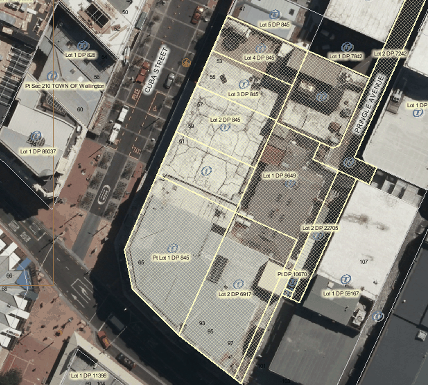
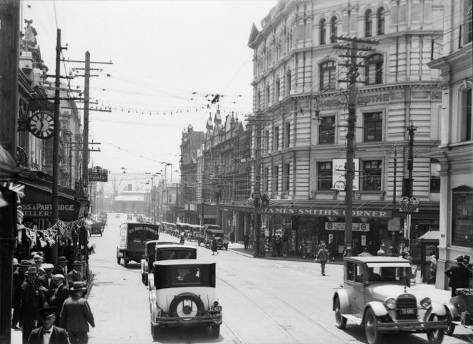
James Smith's department store in c.1920
National Library reference: Cuba Street, Wellington. Smith, Sydney Charles, 1888-1972 :Photographs of New Zealand. Ref: 1/2-048943-G. Alexander Turnbull Library, Wellington, New Zealand. http://natlib.govt.nz/records/22820258
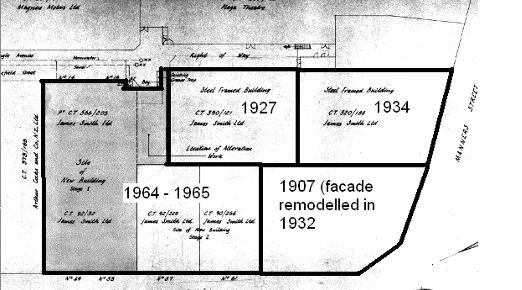
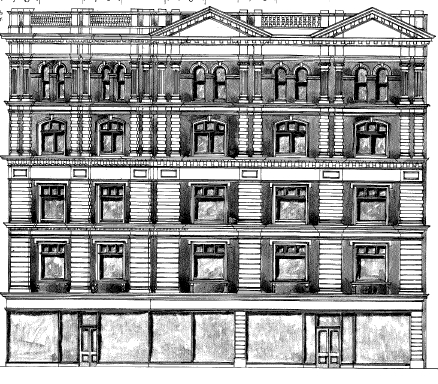
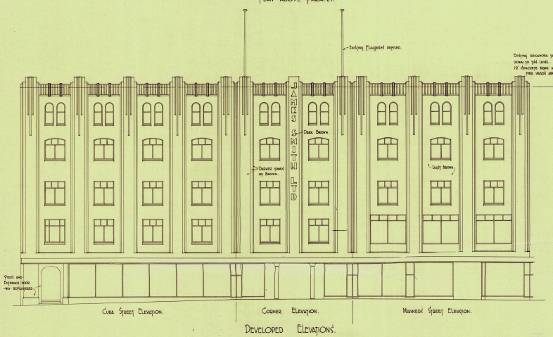
-
Constructed
1907 - 1907
-
Heritage Area
-
Architect(s)
-
Builder(s)
-
The former James Smith Ltd Department Store is made up of five buildings. The original (1907) block has the greatest aesthetic value. It was remodelled in 1932 and is now a good representative example of an Art Deco commercial building. It is notable for its emphatic vertical piers, stepped roof-profile, fluted parapet frieze, and typical 1930s lettering that runs down the central column on the Cuba/Manners Street corner.
The five buildings on the site have a historic association with both the development of Cuba Street as a commercial precinct and with the James Smith department store that was a well known local institution until its closure in 1993.
The 1907/32 building has townscape value for its prominent location on the corner of the Cuba and Manners Street intersection.
-
Downloadable(s)
-
close
History
-
The first of five buildings which would eventually become known as the James Smith Ltd Department Store was erected in 1907 on the corner of Cuba and Manners Street. This new brick building was built for George Winder, an ironmonger, to replace his former shop in the same location. As a result of this the corner came to be known as ‘Winder’s Corner.’ Because his store stocked heavy goods relating to ironmongery, the floors were designed to support over three times the expected amount of weight. The store also sold imported carpets and furniture, with the first floor acting as a show room.
The building was purchased in 1920 by James Smith Ltd. James Smith (?-1902) had been the proprietor of Te Aro House, a large drapery business that was situated on the corner of Dixon and Cuba Street. Smith and his two sons opened a second drapery shop in Cuba Street at some time after 1888 and this business was known as The New House. He died in 1902 but appears to have been succeeded in the business by his sons.
In 1927 James Smith Ltd commissioned a 5-storey, steel framed and concrete reinforced addition that was constructed at the rear of the original building on Pringle Ave. In 1932 the existing building was then refurbished with a new Art Deco façade on the Cuba and Manners Street corner. Further additions facing Manners Street were made in 1934 and two new 3-storey buildings facing Cuba Street were built from 1964 - 1965.
The James Smith Department Store was a popular local establishment and sponsored the local Christmas Parade. The Smith family sold 60% of their holding to the Mace Development Corporation in 1986 and the department store closed in 1993.
The building then became the site of a collection of shops known as James Smith market. The building was described as ‘a shambles’ with shops that were ‘struggling’ to survive, and much of the market closed in the early 2000s. In 2013 the ground floor continued to operate as a retail space, but the remaining floors appeared to be unoccupied (with the notable exception of the gym that appears to occupy most of the c.1964 -65 buildings).
-
Modifications
close
-
1907
-
Erect brick building (00053:141:7851)
-
1927
-
Additions (00056:29:B2909)
-
1932
-
Remodel front (00056:130:B11856)
-
1934
-
Five storey addition (00056:147:B13245)
-
1964
-
New building (00058:321:C13867)
-
1965
-
New building (00058:419:C17929)
-
1981
-
Structural alterations $920,000 (00058:1355:C56877)
-
-
Occupation History
close
-
1897
-
George Winder
-
1921
-
James Smith’s Department Store
-
1993
-
James Smith’s Market James Smith’s Market (various retail stores
-
2000
-
Various retail stores
-
-
-
close
Architectural Information
-
Building Classification(s)
close
Not assessed
-
Architecture
close
The former James Smith Ltd Department Store is comprised of a number of buildings:
Building 1: on the Manners Street Cuba Street corner was built in 1907. It has the greatest aesthetic value, but has undergone many changes and additions over the past 100 years. The heavy Edwardian character of the original building can still be guessed at in the arrangement of windows, particularly in the paired round-headed windows of the top (fourth) floor. The façade was remodelled in 1932 to an Art Deco-style, with emphatic vertical piers, stepped skyline, fluted frieze at parapet level, and typical 1930s lettering that runs vertically down the central column on the Cuba Street/ Manners Street corner. This character follows through into the interior spaces. [1]
Building 2: 93-97 Manners Street was built in 1934. Designed by King and Dawson, the architects for the 1932 façade on the corner building, it was designed to complement the corner building. It is somewhat simpler than that of Building 1, but it has similar Art Deco features that include the decorative parapet, and the expressed external pilasters.
Building 3: on Pringle Ave was constructed in 1927. It appears to have little streetscape value as it can only be viewed from Pringle Ave, a narrow service lane accessed from Wakefield Street.
Buildings 4 & 5: at 49-61 Cuba Street were built in 1964 and 1965 with a mosaic tile façade – this has since been replaced with a modern cladding system. They are three storeys high, and their most notable feature is the well-proportioned stairwell that acts as a ‘book-end’ to the north end of the former James Smith site. -
Materials
close
-
Setting
close
The James Smith Ltd Department Store dominates the intersection between Manners and Cuba Streets. The 1963-1965 additions continue along the eastern length of Cuba Street before joining with heritage buildings at the northern end of the street. On the Manners Street side the 1934 addition is adjoined by a two storey modern building which separates it from the nearby State Opera House. With both its physical presence and historic role as a department store, the James Smith Building continues to contribute to the overall setting of Cuba and Manners Street.
-
Building Classification(s)
close
-
close
Cultural Value
The former James Smith Ltd Department Store is made up of five buildings. The original (1907) block has the greatest aesthetic value. It was remodelled in 1932 and is now a good representative example of an Art Deco commercial building. It is notable for its emphatic vertical piers, stepped roof-profile, fluted parapet frieze, and typical 1930s lettering that runs down the central column on the Cuba/Manners Street corner.
The five buildings on the site have a historic association with both the development of Cuba Street as a commercial precinct and with the James Smith department store that was a well known local institution until its closure in 1993.
The 1907/32 building has townscape value for its prominent location on the corner of the Cuba and Manners Street intersection.
-
Aesthetic Value
close
-
Architectural
Does the item have architectural or artistic value for characteristics that may include its design, style, era, form, scale, materials, colour, texture, patina of age, quality of space, craftsmanship, smells, and sounds?
The former James Smith Ltd Department Store is made up of five buildings. The original (1907) block has the greatest aesthetic value. It was remodelled in 1932 and is now a good representative example of an Art Deco commercial building. It is notable for its emphatic vertical piers, stepped roof-profile, fluted parapet frieze, and typical 1930s lettering that runs down the central column on the Cuba/Manners Street corner.
-
Townscape
Does the item have townscape value for the part it plays in defining a space or street; providing visual interest; its role as a landmark; or the contribution it makes to the character and sense of place of Wellington?
The 1907 /32 building has townscape value for its prominent location on the corner of the Cuba and Manners Street intersection.
-
-
Historic Value
close
-
Association
Is the item associated with an important person, group, or organisation?
The 1907 building was originally built by George Winder, a prominent businessman and city councillor in Wellington at the turn of the twentieth century. The building was later purchased and refurbished by James Smith Ltd, a prominent local department store.
-
Association
Is the item associated with an important historic event, theme, pattern, phase, or activity?
The five buildings on this site have representative historic value for their association with the strong period of development which took place on Cuba Street between 1900 and 1910.
-
-
Scientific Value
close
-
Archaeological
Does the item have archaeological value for its ability to provide scientific information about past human activity?
It is known that there has been pre-1900 human activity on the site as the building is located near the former Te Aro Pa. The building is also located in the Central City archaeological site reference NZAA R27/270
-
-
Social Value
close
-
Identity Sense of Place Continuity
Is the item a focus of community, regional, or national identity? Does the item contribute to sense of place or continuity?
The 1907/32 building’s exterior has had few intrusive alterations in the past 80 years and contributes to the sense of place and continuity of Cuba and Manners Streets.
-
Sentiment - Connection
Is the item a focus of community sentiment and connection?
The buildings were the site of a well-known and well-regarded department store for over seventy years, as well as being a constant feature of Cuba Street. Many Wellingtonians will feel sentiment and connection with this building, although this will diminish over time.
-
-
Level of Cultural Heritage Significance
close
-
Representative
Is the item a good example of the class it represents?
The building’s façade is representative of the Art Deco style.
-
Authentic
Does the item have authenticity or integrity because it retains significant fabric from the time of its construction or from later periods when important additions or modifications were carried out?
Although the original 1907 exterior was refurbished in 1932 the Art Deco façade has retained a significant amount of its original fabric and therefore it has authenticity.
-
Local
Is the item important for any of the above characteristics at a local, regional, national, or international level?
Because the building has helped to define the Cuba and Manners Street intersection and is historically associated with the development of the area it is important on a local level. The building is also important on a national level since it is part of the Cuba Street Heritage Area, a precinct which contains a unique collection of heritage buildings.
-
-
Local / Regional / National / International Importance
close
Not assessed
-
Aesthetic Value
close
-
close
Site Detail
-
District Plan Number
16/ 74/2
-
Legal Description
Pt Lot 1 Dp 845; Lots 2, 3, & 4 DP 845; Lots 1 & 2 DP 6917
-
Heritage New Zealand Listed
2/Historic Place 5379
-
Archaeological Site
Central City NZAA R27/270, Maori site of significance
-
Current Uses
unknown
-
Former Uses
unknown
-
Has building been funded
No
-
Funding Amount
Not applicable
-
Earthquake Prone Status
124 Notice
-
-
close
Additional Information
-
Sources
close
- Dictionary of Scottish Architects. ‘Blake and Penty.’ Accessed 3 September 2012.
- New Zealand Historic Places Trust Professional Biographies. ‘Joseph McClatchie Dawson.’ Accessed 3 September 2012.
- New Zealand Historic Places Trust Professional Biographies. ‘Mitchell and Mitchell.’ Accessed 3 September 2012.
- Wellington City Council. “49-69 Cuba Street.” Wellington Heritage Building Inventory 2001: Non-Residential Precincts. Wellington City Council, 2001. CUBA4.
- Newspapers
- Dominion. Volume 13, Issue 292. 3 September 1920. Page 7.
- Evening Post. Volume LXXVII, Issue 100. 29 April 1909. Page 3.
- Wellington City Archives
- ‘49-69 Cuba Street: Additions.’ March 23 1927. 00056:29:B2909.
- ‘49-69 Cuba Street: Remodel front.’ August 29 1932. 00056:130:B11856.
- ‘49-69 Cuba Street: Five storey addition.’ 26 July 1934. 00056:147:B13245.
- ‘49-69 Cuba Street: Building.’ September 28 1965. 00058:419:C17929.
- Technical Documentation close
-
Footnotes
close
Not available
-
Sources
close
Last updated: 4/20/2017 4:01:22 AM
